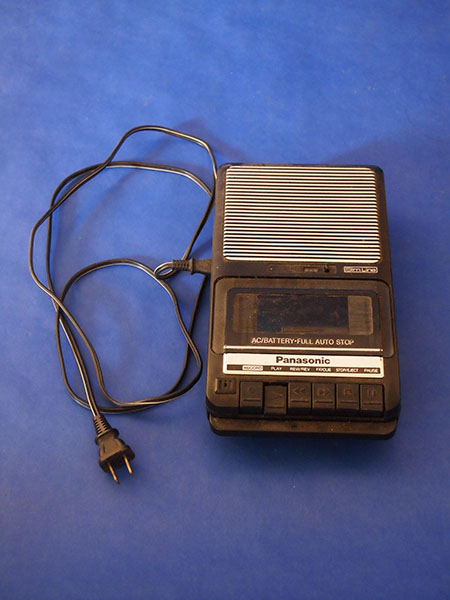![]() body | color | collections | commodity | cube | document | fabric | fetish | gender | glass | home | identity | living | machine | metal | minimal | mobility | narrative | olfactory | organic |
body | color | collections | commodity | cube | document | fabric | fetish | gender | glass | home | identity | living | machine | metal | minimal | mobility | narrative | olfactory | organic |
![]() pain | paper | plastic | plugs | power | protective | rectangular | ritual | round | sound | souvenir | spiritual | style | text-based | time | tool | touch | uniform | value | visual | warm | wood
pain | paper | plastic | plugs | power | protective | rectangular | ritual | round | sound | souvenir | spiritual | style | text-based | time | tool | touch | uniform | value | visual | warm | wood
| Sound: Panasonic Tape Deck | |||
Narrative: Panasonic tape deck.Made in Japan The supply chain for parts is too large and (since they are no longer produced) mysterious to account for here. Sound generation: an electromagnet applies a magnetic flux to the oxide on the tape. The oxide "remembers" the flux it sees. A tape recorder's record head is a very small, circular electromagnet with a small gap in it. The small electromagnet consists of an iron core wrapped with wire. During recording, the audio signal is sent through the coil of wire to create a magnetic field in the core. At the gap, magnetic flux forms a fringe pattern to bridge the gap, and this flux is what magnetizes the oxide on the tape. During playback, the motion of the tape pulls a varying magnetic field across the gap. This creates a varying magnetic field in the core and therefore a signal in the coil. This signal is amplified to drive the speakers. Two small electromagnets are about as wide as one half of the tape's width. Sprockets spin one of the spools to take up the tape during recording, playback, fast forward and reverse. The two sprockets are two heads. The head on the left is a bulk erase head to wipe the tape clean of signals before recording. The head in the center is the record and playback head containing the two tiny electromagnets. The capstan revolves at a very precise rate to pull the tape across the head at exactly the right speed. The standard speed is 1.875 inches per second (4.76 cm per second). The roller simply applies pressure so that the tape is tight against the capstan. I found this at Materials for the Arts, and outpost for unused materials donated to a warehouse in Queens, NY. I used it and another for a performance/reading in Brooklyn where I attached the tape recorder to wheels and a remote control, and they wheeled around the stage playing classical music while the performance happened. Since then, I used them to play tapes purchased at thrift stores. The principle ingredient used in the manufacture of plastic is ethylene, which is derived from petroleum. In this process, ethylene is the polymer, the chemical building block of polyester, and the chemical process that produces the finished polyester is called polymerization. Plastic is manufactured by one of several methods. The one used depends on the form the finished polyester will take. The four basic forms are filament, staple, tow, and fiberfill. In the filament form, each individual strand of polyester fiber is continuous in length, producing smooth-surfaced fabrics. In staple form, filaments are cut to short, predetermined lengths. In this form polyester is easier to blend with other fibers. Tow is a form in which continuous filaments are drawn loosely together. Fiberfill is the voluminous form used in the manufacture of quilts, pillows, and outerwear. The two forms used most frequently are filament and staple. |
 |
||
![]()
